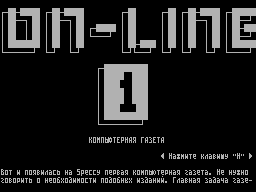|
On-Line #27
10 марта 1996 |
|
Iron - Analog to digital converter.

IRON
(C) LDE SOFT
Before you simple circuit analog-digital converter
allows you to digitize the analog signals with 10 / 8 bit
quality. Despite the simplicity of the scheme, money obtained
otsifrovok comparable to the quality otsifrovok received on
computers IBM / PC or AMIGA, and often surpasses it.
But what to do with these tsifrovkami? I think now
day a lot of talk is not necessary, just briefly remind you:
this manufacturer DIGITAL tools for such well-known musical
Editors, like: DIGITAL STUDIO, SAMPLER, INSTRUMENT, DMM, etc.
Well, of course, the original design of their programs and
megadem. But those who understand a word the ADC, not only as a
toy, capable of recording music or voice into a computer,
provided enormous opportunities for experimenting with analog
signals. K example, using a simple driver, ADC can be converted
into digital oscilloscope, frequency meter, voltmeter,
multimeter, etc.
Let's move on to describe the connection to the ADC
SPECTRUM'u. To connect, I decided to use free ports
AY-3-8910 although you can use whatever you have ports
(Eg VV55, while even a simplified software management
ADC). Now specifically to the scheme: for its assembly have to
buy the chip K1113PV1A Mitinskoe radio market and one (1)
resistor. Connects the ADC 15-th wires (12, 10, 16, 14 - food),
2-9 ADC to 21-14 AY-3-8910, 17 / D to 7 AY, 1918 ADC to 12 AY,
An ADC to 11 AY, 1911 ADC to 13 AY. Further, the scheme is
clear.
Now it's time to describe the bit-ports for use with ADC and
Writing your own driver. Port AY "A" is for the reception
bytes from the ADC data bus. Port "B" is designed to receive
the two youngest of ADC bits (can not be used if desired)
reception from the ADC tone, reset / ADC.
More information about the layout of bits in the port "B":
Bit 0 - quenching / transformation
(0-gashenie/1-preobrazovanie), bit 6 - the willingness ADC
(0-READY) bit 1 - the least significant bit ADC (D0 / D) bit 2
- first bit ADC (D1). Such a strange layout of bits is not
accidental, it's easier to program the ADC. In addition, the
processing of two LSBs ADC requires a lot of cycles Z-80, which
is already not enough, so they removed my own port and you to
decide to use them or not. Personally, I have it reserved and
I'm quite happy with an 8-bit quality otsifrovok.
Features of the ADC control: pin 15 is used for selecting
conversion mode. Let me explain: if the pin 15 logic 0,
ADC then operates in unipolar mode. To switch the ADC in
bipolar mode output 15 should be free. Control signals:
Conclusion 11 / D: suppression / signal conversion. Controlled
bit 0 port "B" AY. Has the following values: 1-quenching
0-conversion. After receiving the signal ADC starts to convert
the analog signal to digital form by the method of successive
approximation. Therefore, the digital code at the ADC output
appears with little delay: approximately 30mks or about 11
cycles Z-80. Must take into account this fact, or poll the ADC
signal readiness (17 ADC output, or 6 bits Port "B" AY). When a
logical 0 on this conclusion the ADC is ready You can shoot
bytes on the data bus. After the ADC provides signal "ready"
should be considered a byte in RAM, then reset ADC (see above)
and give a signal conversion. Otherwise, output ADC will sit
the old byte and you fill the RAM with just one digital
readout.
Oh, I forgot to remind that, for the ADC to -15
(Or, at worst, -12) volts, also recalls that the power supply
from IBM such stresses are.
K 7N / AY
K1113PV1A
K 12n/AY 18 D0 __ 17
K 11n/AY 1 - D1 DR <Login
K 21n/AY 2 D2> 0 <15 R1-4, 7k
K 20n/AY 3 - D3 0VA 14
K 19n/AY 4 - D4 AI 13
K 18n/AY 5 - D5-U2 12 <-15c
K 17n/AY 6 - D6 + U2 10 <+ 5c
K 16n/AY 7 - D7 0VD 16
Other articles:
Similar articles:
В этот день... 31 December